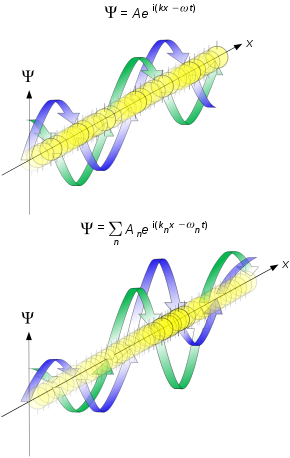Free Particle
In physics, a free particle is a particle that, in some sense, is not bound by an external force, or equivalently not in a region where its potential energy varies.
In classical physics, this means the particle is present in a "field-free" space. In quantum mechanics, it means the particle is in a region of uniform potential, usually set to zero in the region of interest since the potential can be arbitrarily set to zero at any point in space.
Classical free particle
The classical free particle is characterized by a fixed velocity v. The momentum is given by


Quantum free particle

Mathematical description
A free particle with mass 

where ψ is the wavefunction of the particle at position r and time t. The solution for a particle with momentum p or wave vector k, at angular frequency ω or energy E, is given by a complex plane wave:

with amplitude A and has two different rules according to its mass:
- if the particle has mass
:
(or equivalent
).
- if the particle is a massless particle:
.
The eigenvalue spectrum is infinitely degenerate since for each eigenvalue E>0, there corresponds an infinite number of eigenfunctions corresponding to different directions of 
The De Broglie relations: 


As for all quantum particles free or bound, the Heisenberg uncertainty principles 
Measurement and calculations
The integral of the probability density function

where * denotes complex conjugate, over all space is the probability of finding the particle in all space, which must be unity if the particle exists:

This is the normalization condition for the wave function. The wavefunction is not normalizable for a plane wave, but is for a wave packet.
Fourier decomposition
The free particle wave function may be represented by a superposition of momentum eigenfunctions, with coefficients given by the Fourier transform of the initial wavefunction:

where the integral is over all k-space and 







The expectation value of the momentum p for the complex plane wave is

and for the general wave packet it is

The expectation value of the energy E is

Group velocity and phase velocity

The phase velocity is defined to be the speed at which a plane wave solution propagates, namely

Note that 

Meanwhile, suppose that the initial wave function 



which agrees with the formula for the classical velocity of the particle. The group velocity is the (approximate) speed at which the whole wave packet propagates, while the phase velocity is the speed at which the individual peaks in the wave packet move. The figure illustrates this phenomenon, with the individual peaks within the wave packet propagating at half the speed of the overall packet.
Spread of the wave packet
The notion of group velocity is based on a linear approximation to the dispersion relation 

Specifically, it is not difficult to compute an exact formula for the uncertainty 


 is the time-zero wave function. The expression in parentheses in the second term on the right-hand side is the quantum covariance of
is the time-zero wave function. The expression in parentheses in the second term on the right-hand side is the quantum covariance of  and
and  .
. Thus, for large positive times, the uncertainty in 



Relativistic quantum free particle
There are a number of equations describing relativistic particles: see relativistic wave equations.
See also
References
- Quantum Mechanics, E. Abers, Pearson Ed., Addison Wesley, Prentice Hall Inc, 2004, ISBN 978-0-13-146100-0
- Quantum Physics of Atoms, Molecules, Solids, Nuclei, and Particles (2nd Edition), R. Eisberg, R. Resnick, John Wiley & Sons, 1985, ISBN 978-0-471-87373-0
- Stationary States, A. Holden, College Physics Monographs (USA), Oxford University Press, 1971, ISBN 0-19-851121-3
- Hall, Brian C. (2013), Quantum Theory for Mathematicians, Graduate Texts in Mathematics, vol. 267, Springer, ISBN 978-1461471158
- Quantum Mechanics Demystified, D. McMahon, Mc Graw Hill (USA), 2006, ISBN 0-07-145546 9
- Elementary Quantum Mechanics, N.F. Mott, Wykeham Science, Wykeham Press (Taylor & Francis Group), 1972, ISBN 0-85109-270-5
- Quantum mechanics, E. Zaarur, Y. Peleg, R. Pnini, Schaum's Outlines, Mc Graw Hill (USA), 1998, ISBN 007-0540187
- Specific
Further reading
- The New Quantum Universe, T.Hey, P.Walters, Cambridge University Press, 2009, ISBN 978-0-521-56457-1.
- Quantum Field Theory, D. McMahon, Mc Graw Hill (USA), 2008, ISBN 978-0-07-154382-8
- Quantum mechanics, E. Zaarur, Y. Peleg, R. Pnini, Schaum's Easy Outlines Crash Course, Mc Graw Hill (USA), 2006, ISBN 978-007-145533-6
This article uses material from the Wikipedia English article Free particle, which is released under the Creative Commons Attribution-ShareAlike 3.0 license ("CC BY-SA 3.0"); additional terms may apply (view authors). Content is available under CC BY-SA 4.0 unless otherwise noted. Images, videos and audio are available under their respective licenses.
®Wikipedia is a registered trademark of the Wiki Foundation, Inc. Wiki English (DUHOCTRUNGQUOC.VN) is an independent company and has no affiliation with Wiki Foundation.

